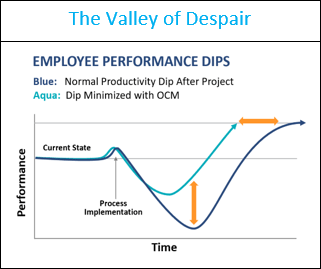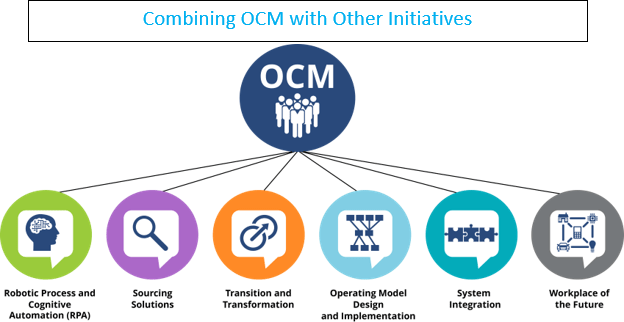Companies often underestimate the degree of change that comes with implementing a new IT system or transitioning services to a new provider. Change can be hard on an organization, and too often, the focus is solely on getting the new technology right or contracting with the best partner. However, studies show the success of a change project actually has more to do with a company’s people than its new IT or service provider-driven capabilities.
Organizational Change Management Should Focus on the People
Say you have a dedicated employee who has been with the company for 20 years. He knows where everything is in the company warehouse and exactly how to get it to where it needs to go. He also understands the steps that other people play in his workflow, both before and after his part. When company leaders decide to deploy new inventory technology or outsource part of the supply chain, this employee’s job will inevitably change. The company can either help the employee understand the changes, explain the reasons and offer support, or let the employee become fearful and disengaged.
 The fact is, all organizations experience a productivity dip as they adapt to new circumstances. Sometimes called “the valley of despair,” the productivity dip coincides with the time it takes employees to adjust to changes in processes and roles. In the past, the prevailing wisdom was to simply weather the storm and hope for the best.
The fact is, all organizations experience a productivity dip as they adapt to new circumstances. Sometimes called “the valley of despair,” the productivity dip coincides with the time it takes employees to adjust to changes in processes and roles. In the past, the prevailing wisdom was to simply weather the storm and hope for the best.
However, organizational change management (OCM) has proven that adequate communication, education and training can help companies minimize the duration and depth of the productivity dip associated with change. This way, a company can realize the projected benefits of a change project faster, keep employee morale from plummeting, and avoid the potential of costly turnover. Investing a certain amount of money upfront to help prepare employees for large-scale impacts to their jobs can save a lot more money down the road.
In recent years, company leaders have also learned you don’t want to consider adding OCM only when dealing with a system implementation or upgrade. The best consulting firms now offer OCM services specifically designed to integrate with all kinds of major changes, including introduction of robotic process automation (RPA)/artificial intelligence, sourcing solutions, other transition and transformation efforts, operating model design and implementation, enterprise resource planning, data/analytics, technology business management, and other efforts designed to facilitate the workplace of the future. A clear methodology, such as ISG’s “Build Up Approach,” can offer a variety of steps to help affected employees know what to expect well in advance of a change, so they feel more comfortable and prepared for what’s to come.

When Considering Your Next Change Project, Keep in Mind the Top 5 Principles of OCM:
1. Align leaders on the project. Business leaders tend to focus almost all their attention on “what” needs to be accomplished with a project without focusing on the “why” or the “how.” But, when it comes to change, it’s the leaders’ job not only to lead the way, but also to prepare others so they can thrive in a changed—and continually changing—environment. And, while many leaders believe organizational change management is purely theoretical or is something that happens organically, OCM is the application of concrete methodologies that have been proven to work. When executives understand the principles of OCM and become advocates for it, that spirit can send positive ripples throughout the organization.
2. Use OCM methodologies to support employees. Recent studies show 62 percent of the issues faced during an IT implementation are people-related. Change projects that lack OCM can result in transaction errors, operational siloes, and process and system workarounds that hinder progress. OCM is an investment in the company’s employees. By providing them with support, training, clear communication and time to focus on the project, they will understand they are the company’s top priority.
3. Let employees get their hands dirty. Just like the company’s leaders, other employees understand the purpose of OCM best when they engage and see it in action. When key employees familiar with the existing systems and processes receive hands-on training and education about the new processes and systems, they can act as trainers for their colleagues, so everyone winds up with a greater understanding of the changes and their expected day-to-day impacts. When employees can think practically about the change process, they are more likely to adapt.
4. Create a process for transferring knowledge. Knowledge transfer is a two-part process aimed at making sure the company can carry out business transformation projects in the future. The first step is for the company’s change personnel to learn how to effectively manage change. The second step is to document what’s needed for future change projects, including charting a clear path to achieving goals and creating a checklist of required activities.
5. Build an OCM team. Yesterday’s OCM practitioners were either subject matter experts with big ideas or diplomats who could facilitate a project and manage relationships. But as technology rapidly evolves, companies often have to go through multiple waves of change, and a chief learning officer and a small training staff aren’t always able to keep up. A dedicated OCM team can help support employees who find that change is becoming more of a constant.
ISG helps companies—their leaders and their employees—better manage change and achieve their transformation goals. Contact us for a free assessment to discuss your next change program or project.
About the author
ISG partner and global OCM leader Randy Geoghagan has more than 25 years of consistent success in building and deploying OCM programs worldwide. He founded TracePoint Consulting in 2009, after spending much of his career as a program manager running large-scale IT-system implementations for big companies, where he saw a clear marketplace need for people who understood the process of change and how to facilitate it well, with a strong focus on the employee experience. He grew TracePoint to appear on the Inc. 500 list of America’s fastest-growing companies, before ISG acquired the firm. Randy continues to take an active role guiding clients through large-scale initiatives with complex business, process and technology changes. He has a bachelor’s in management information systems from the University of Georgia and an MBA from Emory University.
